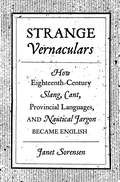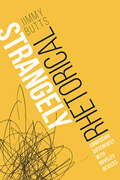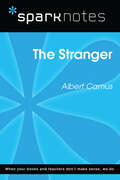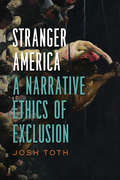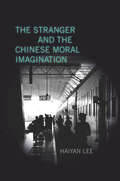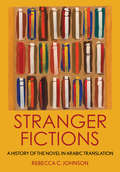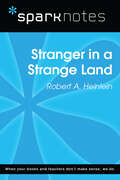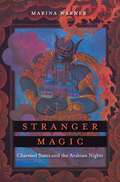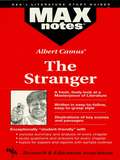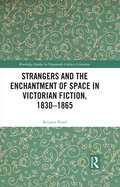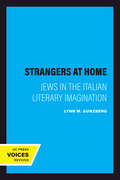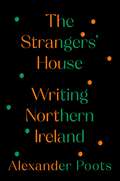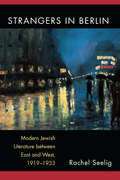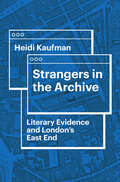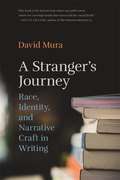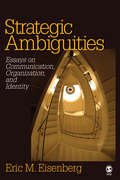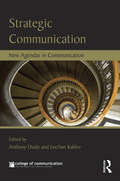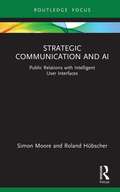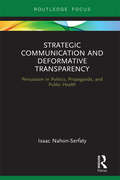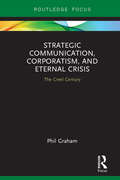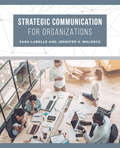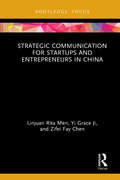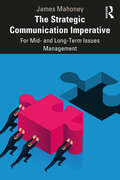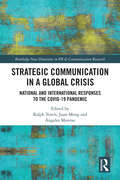- Table View
- List View
Strange Vernaculars: How Eighteenth-Century Slang, Cant, Provincial Languages, and Nautical Jargon Became English
by Janet SorensenHow vocabularies once associated with outsiders became objects of fascination in eighteenth-century BritainWhile eighteenth-century efforts to standardize the English language have long been studied—from Samuel Johnson's Dictionary to grammar and elocution books of the period—less well-known are the era's popular collections of odd slang, criminal argots, provincial dialects, and nautical jargon. Strange Vernaculars delves into how these published works presented the supposed lexicons of the "common people" and traces the ways that these languages, once shunned and associated with outsiders, became objects of fascination in printed glossaries—from The New Canting Dictionary to Francis Grose's Classical Dictionary of the Vulgar Tongue—and in novels, poems, and songs, including works by Daniel Defoe, John Gay, Samuel Richardson, Robert Burns, and others.Janet Sorensen argues that the recognition and recovery of outsider languages was part of a transition in the eighteenth century from an aristocratic, exclusive body politic to a British national community based on the rhetoric of inclusion and liberty, as well as the revaluing of a common British past. These representations of the vernacular made room for the "common people" within national culture, but only after representing their language as "strange." Such strange and estranged languages, even or especially in their obscurity, came to be claimed as British, making for complex imaginings of the nation and those who composed it. Odd cant languages, witty slang phrases, provincial terms newly valued for their connection to British history, or nautical jargon repurposed for sentimental connections all toggle, in eighteenth-century jest books, novels, and poems, between the alluringly alien and familiarly British.Shedding new light on the history of the English language, Strange Vernaculars explores how eighteenth-century British literature transformed the patois attributed to those on the margins into living symbols of the nation.Examples of slang from Strange Vernaculars bum-boat woman: one who sells bread, cheese, greens, and liquor to sailors from a small boat alongside a ship collar day: execution day crewnting: groaning, like a grunting horse gentleman's companion: lice gingerbread-work: gilded carvings of a ship's bow and stern luggs: ears mort: a large amount thraw: to argue hotly and loudly
Strangely Rhetorical: Composing Differently With Novelty Devices
by Jimmy ButtsStrangely Rhetorical establishes the groundwork for strangeness as a lens under the broader interdisciplinary umbrella of rhetoric and composition and shares a series of rhetorical devices for practically thinking about how compositions are made unique. Jimmy Butts explores how strange, novel, weird, and interesting texts work and offers insight into how and why these forms can be invented, created, and stylized to generate the effective delivery of rhetorical messages in fun, divergent ways. Using a new theoretical framework—that strangeness is inherent within all rhetorical interactions and is potentially useful—Butts demonstrates how rhetoric is always already coming from an Other, offering an ethical context for how defamiliarized texts work with different audiences. Applying examples of seven figures for composing in and across written, aural, visual, electronic, and spatial texts (the WAVES of media), Butts shows how divergence is possible in all sorts of refigured multimodal ways. Strangely Rhetorical rethinks what exactly rhetoric is and does, considering the ways that strange compositions help rhetors connect across a broad range of networks in a world haunted by distance. This is a book about strange rhetoric for makers and creatives, for students and teachers, and for composers of all sorts.
The Stranger (SparkNotes Literature Guide Series)
by SparkNotesThe Stranger (SparkNotes Literature Guide) by Albert Camus Making the reading experience fun! Created by Harvard students for students everywhere, SparkNotes is a new breed of study guide: smarter, better, faster. Geared to what today's students need to know, SparkNotes provide: *Chapter-by-chapter analysis *Explanations of key themes, motifs, and symbols *A review quiz and essay topics Lively and accessible, these guides are perfect for late-night studying and writing papers
Stranger America: A Narrative Ethics of Exclusion (Cultural Frames, Framing Culture)
by Josh TothContradictory ideals of egalitarianism and self-reliance haunt America’s democratic state. We need look no further than Donald Trump’s 2016 presidential campaign and victory for proof that early twentieth-century anxieties about individualism, race, and the foreign or intrusive "other" persist today. In Stranger America, Josh Toth tracks and delineates these anxieties in America’s aesthetic production, finally locating a potential narrative strategy for circumnavigating them.Toth’s central focus is, simply, strangeness—or those characters who adamantly resist being fixed in any given category of identity. As with the theorists employed (Nancy, i ek, Derrida, Freud, Hegel), the subjects and literature considered are as encompassing as possible: from the work of Herman Melville, William Faulkner, James Weldon Johnson, and Nella Larsen to that of Philip K. Dick, Woody Allen, Larry David, and Bob Dylan; from the rise of nativism in the early twentieth century to object-oriented ontology and the twenty-first-century zombie craze; from ragtime and the introduction of sound in American cinema to the exhaustion of postmodern metafiction.Toth argues that American literature, music, film, and television can show us the path toward a new ethic, one in which we organize identity around the stranger rather than resorting to tactics of pure exclusion or inclusion. Ultimately, he provides a new narrative approach to otherness that seeks to realize a truly democratic form of community.
The Stranger and the Chinese Moral Imagination
by Haiyan LeeIn the last two decades, China has become a dramatically more urban society and hundreds of millions of people have changed residence in the process. Family and communal bonds have been broken in a country once known as "a society of kith and kin. " There has been a pervasive sense of moral crisis in contemporary China, and the new market economy doesn't seem to offer any solutions. This book investigates how the Chinese have coped with the condition of modernity in which strangers are routinely thrust together. Haiyan Lee dismisses the easy answers claiming that this "moral crisis" is merely smoke and mirrors conjured up by paternalistic, overwrought leaders and scholars, or that it can be simply chalked up to the topsy-turvy of a market economy on steroids. Rather, Lee argues that the perception of crisis is itself symptomatic of a deeper problem that has roots in both the Confucian tradition of kinship and the modern state management of stranger sociality. This ambitious work is the first to investigate the figure of the stranger-foreigner, peasant migrant, bourgeois intellectual, class enemy, unattached woman, animal-across literature, film, television, and museum culture. Lee's aim is to show that hope lies with a robust civil society in which literature and the arts play a key role in sharpening the moral faculties and apprenticing readers in the art of living with strangers. In so doing, she makes a historical, comparative, and theoretically informed contribution to the on-going conversation on China's "(un)civil society. "
Stranger Fictions: A History of the Novel in Arabic Translation
by Rebecca C. JohnsonZaynab, first published in 1913, is widely cited as the first Arabic novel, yet the previous eight decades saw hundreds of novels translated into Arabic from English and French. This vast literary corpus influenced generations of Arab writers but has, until now, been considered a curious footnote in the genre's history. Incorporating these works into the history of the Arabic novel, Stranger Fictions offers a transformative new account of modern Arabic literature, world literature, and the novel.Rebecca C. Johnson rewrites the history of the global circulation of the novel by moving Arabic literature from the margins of comparative literature to its center. Considering the wide range of nineteenth- and early twentieth-century translation practices—including "bad" translation, mistranslation, and pseudotranslation—Johnson argues that Arabic translators did far more than copy European works; they authored new versions of them, producing sophisticated theorizations of the genre. These translations and the reading practices they precipitated form the conceptual and practical foundations of Arab literary modernity, necessitating an overhaul of our notions of translation, cultural exchange, and the global.Examining nearly a century of translations published in Beirut, Cairo, Malta, Paris, London, and New York, from Qiat Rūbinun Kurūzī (The story of Robinson Crusoe) in 1835 to pastiched crime stories in early twentieth-century Egyptian magazines, Johnson shows how translators theorized the Arab world not as Europe's periphery but as an alternative center in a globalized network. Stranger Fictions affirms the central place of (mis)translation in both the history of the novel in Arabic and the novel as a transnational form itself.
Stranger in a Strange Land (SparkNotes Literature Guide Series)
by SparkNotesStranger in a Strange Land (SparkNotes Literature Guide) by Robert A. Heinlein Making the reading experience fun! Created by Harvard students for students everywhere, SparkNotes is a new breed of study guide: smarter, better, faster. Geared to what today's students need to know, SparkNotes provide: *Chapter-by-chapter analysis *Explanations of key themes, motifs, and symbols*A review quiz and essay topicsLively and accessible, these guides are perfect for late-night studying and writing papers.
Stranger Magic: Charmed States and the Arabian Nights
by Marina WarnerOur foremost theorist of myth, fairytales, and folktales explores the magical realm of the imagination where carpets fly, objects speak, dreams reveal hidden truths, and genies grant prophetic wishes. Stranger Magic examines the wondrous tales of the Arabian Nights, their profound impact on the West, and the progressive exoticization of magic since the eighteenth century, when the first European translations appeared. The Nights seized European readers’ imaginations during the siècle des Lumières, inspiring imitations, spoofs, turqueries, extravaganzas, pantomimes, and mauresque tastes in dress and furniture. Writers from Voltaire to Goethe to Borges, filmmakers from Raoul Walsh on, and countless authors of children’s books have adapted its stories. What gives these tales their enduring power to bring pleasure to readers and audiences? Their appeal, Marina Warner suggests, lies in how the stories’ magic stimulates the creative activity of the imagination. Their popularity during the Enlightenment was no accident: dreams, projections, and fantasies are essential to making the leap beyond the frontiers of accepted knowledge into new scientific and literary spheres. The magical tradition, so long disavowed by Western rationality, underlies modernity’s most characteristic developments, including the charmed states of brand-name luxury goods, paper money, and psychoanalytic dream interpretation. In Warner’s hands, the Nights reveal the underappreciated cultural exchanges between East and West, Islam and Christianity, and cast light on the magical underpinnings of contemporary experience, where mythical principles, as distinct from religious belief, enjoy growing acceptance. These tales meet the need for enchantment, in the safe guise of oriental costume.
The Stranger (MAXNotes Literature Study Guides)
by Kevin KellyREA's MAXnotes for Albert Camus' The Stranger MAXnotes offer a fresh look at masterpieces of literature, presented in a lively and interesting fashion. Written by literary experts who currently teach the subject, MAXnotes will enhance your understanding and enjoyment of the work. MAXnotes are designed to stimulate independent thought about the literary work by raising various issues and thought-provoking ideas and questions. MAXnotes cover the essentials of what one should know about each work, including an overall summary, character lists, an explanation and discussion of the plot, the work's historical context, illustrations to convey the mood of the work, and a biography of the author. Each section of the work is individually summarized and analyzed, and has study questions and answers.
Strangers and the Enchantment of Space in Victorian Fiction, 1830–1865 (Routledge Studies in Nineteenth Century Literature)
by Kristen PondTracing the origins of how we think about strangers to the Victorian period, Strangers and the Enchantment of Space in Victorian Fiction, 1830-1865 explores the vital role strangers had in shaping social relations during the cultural transformations of the industrial revolution, transportation technologies, and globalization. While studies of nineteenth-century Britain tend to trace the rise of an aloof cosmopolitanism and distancing narrative strategies, this volume calls attention to the personalizing impulse in nineteenth-century literary form, investigating the deeply personal reflections on individual and national identities. In her book, Dr. Pond leads the reader through homes of the urban poor, wandering the Great Exhibition in the Crystal Palace, loitering in suburban neighborhoods, riding the railway, and touring a country estate. Readers will experience how the ordinary can be enchanting, and how the mundane can be unexpected, discovering a new way of thinking about strangers and their influence on our lives. Through an examination of the short and long fictional forms of Martineau, Dickens, Brontë, Gaskell, and Braddon, this study locates the figure of the stranger as a powerful topos in the story Victorian literature and the ethics of social relations. This book will be ideal for those seeking to understand the dynamics of the stranger in Victorian fiction as a figure for understanding the changing dynamics of social relations in England in the early nineteenth century.
Strangers at Home: Jews in the Italian Literary Imagination
by Lynn M. GunzbergUsing popular literature as a window on Italian society and its values, Lynn Gunzberg explores the representation of Jews in novels and poetry written by non-Jews from the beginning of the Risorgimento in the early 1800s to the enactment of the Fascist racial laws in 1938. She shows how the literature of that period contradicts the popular belief that anti-Semitism simply did not exist in Italy until late in the Fascist period.
The Strangers' House: Writing Northern Ireland
by Alexander PootsA penetrating study and celebration of Northern Irish literature—telling the region&’s story through the extraordinary novels and poetry produced by decades of conflict. Northern Ireland is one hundred years old. Northern Ireland does not exist. Both of these statements are true. It just depends who you ask. How do you write about a place like this? THE STRANGERS' HOUSE asks this question of the region&’s greatest writers, living and dead. What have they made of Northern Ireland – and what has Northern Ireland made of them? Northern Ireland is roughly the same size as the State of Connecticut, yet has produced an extraordinary number of celebrated poets and novelists. Louis MacNeice, too clever to be happy, formed by his childhood on the shores of Belfast Lough; son of a Protestant clergyman &“banned for ever from the candles of the Irish poor&”. C. S. Lewis, who discovered Narnia in the rolling drumlins and black rock of County Down. Anna Burns, chronicler of North Belfast and winner of the Booker Prize. And Seamus Heaney, the man of wry precision, the poet with the gift of surprise. As well as household names, Poots also examines writers who may be less familiar to an American readership. These include the dark and bawdy novels of Ian Cochrane, a half-blind writer obsessed with Columbo, and Forrest Reid, a man who saw Arcadia in the Irish countryside, and who was, perhaps, the North&’s first queer author. Reading the work of these writers together produces a testament to over one hundred years of literary endeavor and human struggle. THE STRANGERS' HOUSE is the story of how men and women have written about a home divided, and used their work to move, in the words of Seamus Heaney, &“like a double agent among the big concepts.&”
Strangers in Berlin: Modern Jewish Literature between East and West, 1919–1933
by Rachel Elana SeeligBerlin in the 1920s was a cosmopolitan hub where for a brief, vibrant moment German-Jewish writers crossed paths with Hebrew and Yiddish migrant writers. Working against the prevailing tendency to view German and East European Jewish cultures as separate fields of study, Strangers in Berlin is the first book to present Jewish literature in the Weimar Republic as the product of the dynamic encounter between East and West. Whether they were native to Germany or sojourners from abroad, Jewish writers responded to their exclusion from rising nationalist movements by cultivating their own images of homeland in verse, and they did so in three languages: German, Hebrew, and Yiddish. Author Rachel Seelig portrays Berlin during the Weimar Republic as a "threshold" between exile and homeland in which national and artistic commitments were reexamined, reclaimed, and rebuilt. In the pulsating yet precarious capital of Germany's first fledgling democracy, the collision of East and West engendered a broad spectrum of poetic styles and Jewish national identities.
Strangers in Blood
by Jean E. FeerickStrangers in Blood explores, in a range of early modern literature, the association between migration to foreign lands and the moral and physical degeneration of individuals. Arguing that, in early modern discourse, the concept of race was primarily linked with notions of bloodline, lineage, and genealogy rather than with skin colour and ethnicity, Jean E. Feerick establishes that the characterization of settler communities as subject to degenerative decline constituted a massive challenge to the fixed system of blood that had hitherto underpinned the English social hierarchy.Considering contexts as diverse as Ireland, Virginia, and the West Indies, Strangers in Blood tracks the widespread cultural concern that moving out of England would adversely affect the temper and complexion of the displaced individual, changes that could be fought only through willed acts of self-discipline. In emphasizing the decline of blood as found at the centre of colonial narratives, Feerick illustrates the unwitting disassembling of one racial system and the creation of another.
Strangers in the Archive: Literary Evidence and London’s East End (Victorian Literature and Culture Series)
by Heidi KaufmanTraditionally the scene of some of London’s poorest, most crime-ridden neighborhoods, the East End of London has long been misunderstood as abject and deviant. As a landing place for migrants and newcomers, however, it has also been memorably and colorfully represented in the literature of Victorian authors such as Charles Dickens and Oscar Wilde. In Strangers in the Archive, Heidi Kaufman applies the resources of archives both material and digital to move beyond icon and stereotype to reveal a deeper understanding of East End literature and culture in the Victorian age.Kaufman uncovers this engaging new perspective on the East End through Maria Polack’s Fiction without Romance (1830), the first novel to be published by an English Jew, and through records of Polack’s vibrant community. Although scholars of nineteenth-century London and readers of East End fictions persist in privileging sensational narratives of Jack the Ripper and the infamous "Fagin the Jew" as signs of universal depravity among East End minority ethnic and racial groups, Strangers in the Archive considers how archival materials are uniquely capable of redressing cultural silences and marginalized perspectives as well as reshaping conceptions of the global significance of literary and print culture in nineteenth-century London.Many of this book’s subjects—including digital editions of rare books and manuscript diaries, multimedia maps, and other related East End print records—can be viewed online at the Lyon Archive and the Polack Archive.
A Stranger's Journey: Race, Identity, and Narrative Craft in Writing
by David MuraIn this book, the author poses two central questions. The first involves identity: How is writing an exploration of who one is and one’s place in the world? The author examines how the myriad identities in our changing contemporary canon have led to new challenges regarding both craft and pedagogy. Here, like Toni Morrison’s Playing in the Dark or Jeff Chang’s Who We Be, A Stranger’s Journey breaks new ground in our understanding of the relationship between the issues of race, literature, and culture. The book’s second central question involves structure: How does one tell a story? The author provides clear, insightful narrative tools that any writer may use, taking in techniques from fiction, screenplays, playwriting, and myth. Through this process, he candidly explores the newly evolved aesthetic principles of memoir and how questions of identity occupy a central place in contemporary memoir.
Strategic Ambiguities: Essays on Communication, Organization, and Identity
by Eric M. Eisenberg"Eisenberg′s book is refreshing, in addition to its theoretical merits, for the presence of a distinctive human voice, unafraid to express passion, anger and hope. Readers will benefit enormously from the substance of his book, but also from its form."—HUMAN RELATIONSIn Strategic Ambiguities: Essays on Communication, Organization, and Identity, Eric M. Eisenberg, an internationally recognized leader in the theory and practice of organizational communication, collects and reflects upon more than two decades of his writing. Strategic Ambiguities is a provocative journey through the development of a new aesthetics of communication that rejects fundamentalisms and embraces a contingent, life-affirming worldview. Strategic Ambiguities: Explores the role of language and communication in the construction of social structures and personal identities. Provides a useful intellectual and historical context for students through framing chapters and head notes developed especially for this volume.Chronicles the historical development of an important argument about communicating and organizing through the sustained focus on a single theorist.Intended Audience:This text is designed for advanced undergraduate and graduate courses such as Organizational Communication, Communication Theory, and Organizational Behavior in the fields of Communication, Business & Management, and Educational Leadership."This collection of essays is insightful, thought-provoking, and forward-looking. Eric Eisenberg takes on challenging positions, writes in a cogent and accessible manner, and always stimulates new scholarship. This work will be an important teaching tool, not just for the innovative content of the writing, but also for the historical narrative of organizational communication embedded in it." —Steve May, University of North Carolina at Chapel Hill"Lay audiences will find the text rich with evocative narratives even as the theoretical moves will engage students and teacher-scholars. This edited compilation is likely to serve as a springboard for future inquiry and an invaluable resource for teaching and learning in undergraduate and graduate communication courses." —THE REVIEW OF COMMUNICATION
Strategic Communication: New Agendas in Communication (New Agendas in Communication Series)
by Anthony Dudo LeeAnn KahlorThe focus of this book is Strategic Communication. Communication can be defined as strategic if its development and/or dissemination is driven by an expected outcome. These outcomes can be attitudinal, behavioral, persuasive or knowledge-related; they can lead to change or engagement, or they can miss their mark entirely. In looking at strategic communication, one is not limited to a specific context or discipline. Many of the scholars in the volume are generating research that covers strategic communication in ways that are meaningful across fields. This volume collects the work and idea of scholars who cover the spectrum of strategic communication from source to message to audience to channel to effects. Strategic Communication offers news perspectives across contexts and is rooted firmly in the rich research traditions of persuasion and media effects. Spanning multiple disciplines and written to appeal to a large audience, this book will be found in the hands of researchers, graduate students, and students doing interdisciplinary coursework.
Strategic Communication and AI: Public Relations with Intelligent User Interfaces (Routledge Insights in Public Relations Research)
by Simon Moore Roland HübscherThis concise text provides an accessible introduction to Artificial Intelligence and Intelligent User Interfaces (IUIs) and how they are at the heart of a communication revolution for strategic communications and public relations. Intelligent user interfaces are where users and technology meet - via computers, phones, robots, public displays etc. They use AI and machine learning methods to control how those systems interact, exchange data, learn from and develop relations with users. The authors explore research and developments that are already changing human/machine engagement in a wide range of areas from consumer goods, healthcare and entertainment to community relations, crisis management and activism. They also explore the implications for public relations of how technologies developing hyper-personalized persuasion could be used to make choices for us, navigating the controversial space between influence, nudging, and controlling. This readable overview of the applications and implications of AI and IUIs will be welcomed by researchers, students and practitioners in all areas of strategic communication, public relations and communications studies.
Strategic Communication and Deformative Transparency: Persuasion in Politics, Propaganda, and Public Health (Routledge Focus on Communication Studies)
by Isaac Nahon-SerfatyThis book examines deformative transparency and its different manifestations in political communication, propaganda and public health. The objective is to present the theoretical foundations of deformative transparency, as grotesque and esperpentic transparency, and illustrate the validity of such approach to understand the strategic and ethical implications of the proactive disclosure of the "shocking", "ugly" or "outside the norm". Four areas are discussed: political communication with particular focus on populist politicians as the deceased Venezuelan president Hugo Chávez, the campaign and presidency of Donald Trump, and the tenure in office of the mayor of Toronto, Rob Ford; propaganda strategies of Islamist terrorist organizations such as the Islamic State’s escalation of the visually horrific; and public health campaigns that use "disturbing images" to promote public awareness and eventually influence behavioural change. This study on the transparently grotesque is part of a research program about the economy of emotions in public communication.
Strategic Communication, Corporatism, and Eternal Crisis: The Creel Century
by Phil GrahamThis book traces a century of militarised communication that began in the United States in April, 1917, with the institution of the Committee on Public Information (CPI), headed by George Creel and tasked with persuading a divided US public to enter World War I. Creel achieved an historic feat of communication: a nationalising mass mediation event well before any instantaneous mass media technologies were available. The CPI’s techniques and strategies have underpinned marketing, public relations, and public diplomacy practices ever since. The book argues that the CPI’s influence extends unbroken into the present day, as it provided the communicative and attitudinal bases for a new form of political economy, a form of corporatism, that would come to its fullest flower in the “globalisation” project of the mid-1990s.
Strategic Communication for Organizations
by Sara LaBelle Jennifer H. WaldeckStrategic Communication for Organizations elucidates the emerging research on strategic communication, particularly as it operates in a variety of organizational settings. This book, appropriate for both students and practitioners, emphasizes how theory and research from the field of communication studies can be used to support and advance organizations of all types across a variety of business sectors. Grounded in scholarship and organizational cases, this textbook: focuses on message designprovides introductory yet comprehensive coverage of how strategy and message design enable effective organizational and corporate communicationexplores how theory and research can be synthesized to inform modern communication-based campaignsStrategic Communication for Organizations will help readers discuss how to develop, implement, and evaluate messages that are consistent with an organization’s needs, mission, and vision, effectively reaching and influencing internal and external audiences.
Strategic Communication for Startups and Entrepreneurs in China (Routledge Insights in Public Relations Research)
by Linjuan Rita Men Yi Grace Ji Zifei Fay ChenThis book presents a comprehensive guide for public relations and strategic communication professionals and entrepreneurs to effectively manage the communication aspects of startups in the context of business in China. Drawing on interdisciplinary theories, current issues, and updated research evidence obtained from entrepreneurs and startup leaders in China, this concise volume provides research-based insights on the best practices for public relations and strategic communication in the unique context of startups. It addresses relationships with stakeholders, public relations practice, leadership communication, and how to leverage the power of social media in the entrepreneurial context. Strategic Communication for Startups and Entrepreneurs in China will be of great benefit to public relations and strategic communication scholars and practitioners, startup leaders and entrepreneurs interested in opportunities in China, and advanced students in public relations, business communication, and entrepreneurship.
The Strategic Communication Imperative: For Mid- and Long-Term Issues Management
by James MahoneyThis book proposes a model for directly aligning strategic communication with organisational business planning to enable effective management of mid- to long-term organisational issues. It argues that current conceptualisations of strategic communication need to be extended to locate it more precisely within definitions of strategy and as an essential element of mid- and long-term business planning. This approach re-positions strategic issues communication in a professional practice dimension that has a specific focus on issues that do not immediately impact on an organisation’s ability to achieve its day-to-day business goals. Full of contemporary examples from business, and including a thorough explanation of how the model can be applied in professional practice, the book will prove illuminating reading for scholars, students, and professionals alike.
Strategic Communication in a Global Crisis: National and International Responses to the COVID-19 Pandemic (Routledge New Directions in PR & Communication Research)
by Ralph Tench Juan Meng Ángeles MorenoThis edited volume makes a unique and timely contribution by exploring in depth the topic of strategic communication and COVID-19 from a global perspective. It’s widely agreed that effective and timely communication and leadership are crucial to the successful management of any pandemic. With the ongoing and possibly long-lasting impact COVID-19 has generated to many aspects of communication and multiple sectors of our societies, it is critical to explore the role of strategic communication in change management during the COVID-19 pandemic and beyond. Therefore, this book addresses such a need and is thoroughly grounded in rich empirical evidence gained through a global study of COVID-19 communication experiences and strategies. In the second half of 2020, a transnational team of senior researchers conducted research to investigate COVID-19 communications (COM-COVID-19) in different countries, representing Europe, Africa, Latin America, North America, South America, and Asia. The results presented in this book provide a compelling, current picture of the COVID-19 pandemic and strategic communication globally. Chapters individually explore the national and regional experiences and discuss relevant success and failures of pandemic communication and specific learning from the 2020/21 crises. By emphasizing the discussion on key communication channels, sources of information, facts and concerns as related to the COVID-19 pandemic, the editors call for actions to develop effective strategies within unique national contexts, which can shed light on global expectations on necessary public health responses and communication. This book is written for scholars, educators and professionals in communication, public relations, strategic communication and corporate communication. It is also appropriate to use this book as a supplementary text for advanced undergraduate and graduate courses on relevant courses.
